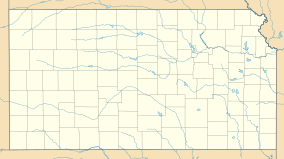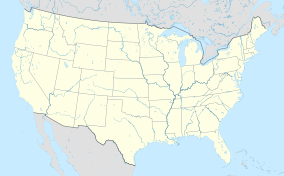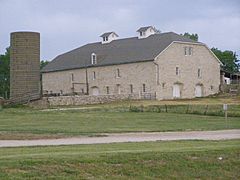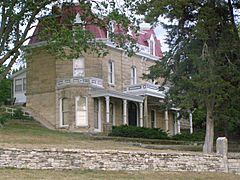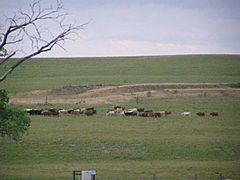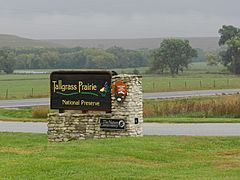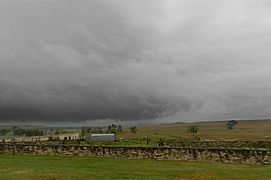Tallgrass Prairie National Preserve facts for kids
Quick facts for kids Tallgrass Prairie National Preserve |
|
|---|---|
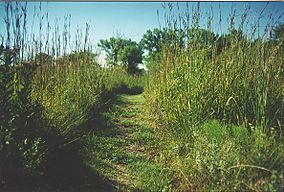
Tallgrass Prairie National Preserve
|
|
| Location | Chase County, Kansas |
| Nearest city | Strong City, Kansas |
| Area | 10,882 acres (44.04 km2) |
| Established | November 12, 1996 |
| Visitors | 29,378 (in 2016) |
| Governing body | National Park Service, The Nature Conservancy |
| Website | Tallgrass Prairie National Preserve |
The Tallgrass Prairie National Preserve is a special place in Kansas, United States. It's a National Preserve that protects a huge area of tallgrass prairie. This type of grassland used to cover a lot of North America. But now, less than 4% of it is left. Most of what remains is in the Flint Hills region of Kansas, where the preserve is located. Since 2009, a growing herd of bison has lived here.
Contents
Exploring the Tallgrass Prairie
The National Park Service (NPS) and The Nature Conservancy work together to protect this amazing prairie. They also share its stories. You can learn about the history of ranching, the lives of American Indian people, and all the different plants and animals that live in the tallgrass prairie.
There are over 40 miles (64 km) of hiking trails for visitors to explore. These trails let you walk right into the tallgrass prairie. If you visit in the summer, you can even take a bus tour with a guide who tells you all about the prairie.
|
|
History of the Spring Hill Ranch
The land that is now the preserve was once a large cattle ranch called Spring Hill Ranch. Stephen F. Jones, a rancher from Tennessee, started building the ranch in 1878. By 1881, he had finished the main ranch buildings.
How Ranching Changed
Stephen F. Jones was one of the first ranchers in the area to use "enclosed ranching." This meant he used stone walls, fences, and even barbed wire to keep his cattle in certain areas. This was a big change from the "open range" style of ranching. In the 1880s, many ranchers started using fences because too many animals were eating all the grass on the open range.
Jones made his ranch very big, about 7,000 acres (2,800 ha). He built a beautiful ranch house in 1881 that cost around $25,000. He also gave land to build the Lower Fox Creek School, a one-room schoolhouse. Jones raised many types of purebred cattle, hogs, and sheep on his ranch.
New Owners and Recognition
In 1888, Jones sold the ranch to the Lantry family. They continued to raise cattle until 1904. Later, the ranch was divided into smaller pieces. But in 1935, a grain dealer named George Davis bought all the pieces and put the ranch back together. After he passed away in 1955, the property became known as the Z-Bar Ranch.
People started to become interested in protecting this historic ranch in the 1960s. Local groups helped restore the Lower Fox Creek School. In 1971, the ranch was added to the National Register of Historic Places. This means it's an important historical site. Later, in 1997, the entire ranch became a National Historic Landmark District. This was because of Stephen F. Jones and how his ranch showed the end of the open range ranching era.
Creating the National Preserve
The 10,882-acre (4,404 ha) preserve was once the Spring Hill/Z-Bar Ranch. The National Park Trust bought it in 1994.
A New Idea for a Park
In 1991, there was a plan to create a national preserve here. But some local people didn't like the idea of the National Park Service owning all the land. So, U.S. Senator Nancy Kassebaum brought together different groups to find a solution. In 1992, they came up with a new idea: a "public/private partnership." This meant the park would be managed by the National Park Service, but most of the land would be owned by a private group.
The Preserve is Born
In 1994, Senators Kassebaum and Bob Dole introduced a bill in Congress. This bill allowed the government to create the preserve with the public/private ownership plan. The bill said the National Park Service could only own a small part (no more than 180 acres (73 ha)) of the preserve. The rest would be owned by the National Park Trust. Both groups would work together to manage the new park. On November 12, 1996, this bill became a law, creating the Tallgrass Prairie National Preserve.
In 2002, the National Park Trust gave about 32 acres (13 ha) of land to the National Park Service. This included the historic ranch house, the limestone barn, other buildings, and the one-room schoolhouse. The National Park Trust worked with the National Park Service to plan and develop the park from 1996 to 2005.
The law allowed another non-profit group to take over ownership of the land. So, in 2005, the National Park Trust sold about 10,862 acres (4,396 ha) to The Nature Conservancy. This group now owns most of the land, continuing the special public/private partnership.
In 2008, the Tallgrass Prairie National Preserve was named one of the "8 Wonders of Kansas."
Bison Return to the Prairie
In 2009, The Nature Conservancy brought a small herd of bison back to the Tallgrass Prairie National Preserve. These animals are an important part of the prairie ecosystem. To keep the prairie healthy, about a third of the grasslands are burned each year. This helps new plants grow and keeps the prairie strong.


